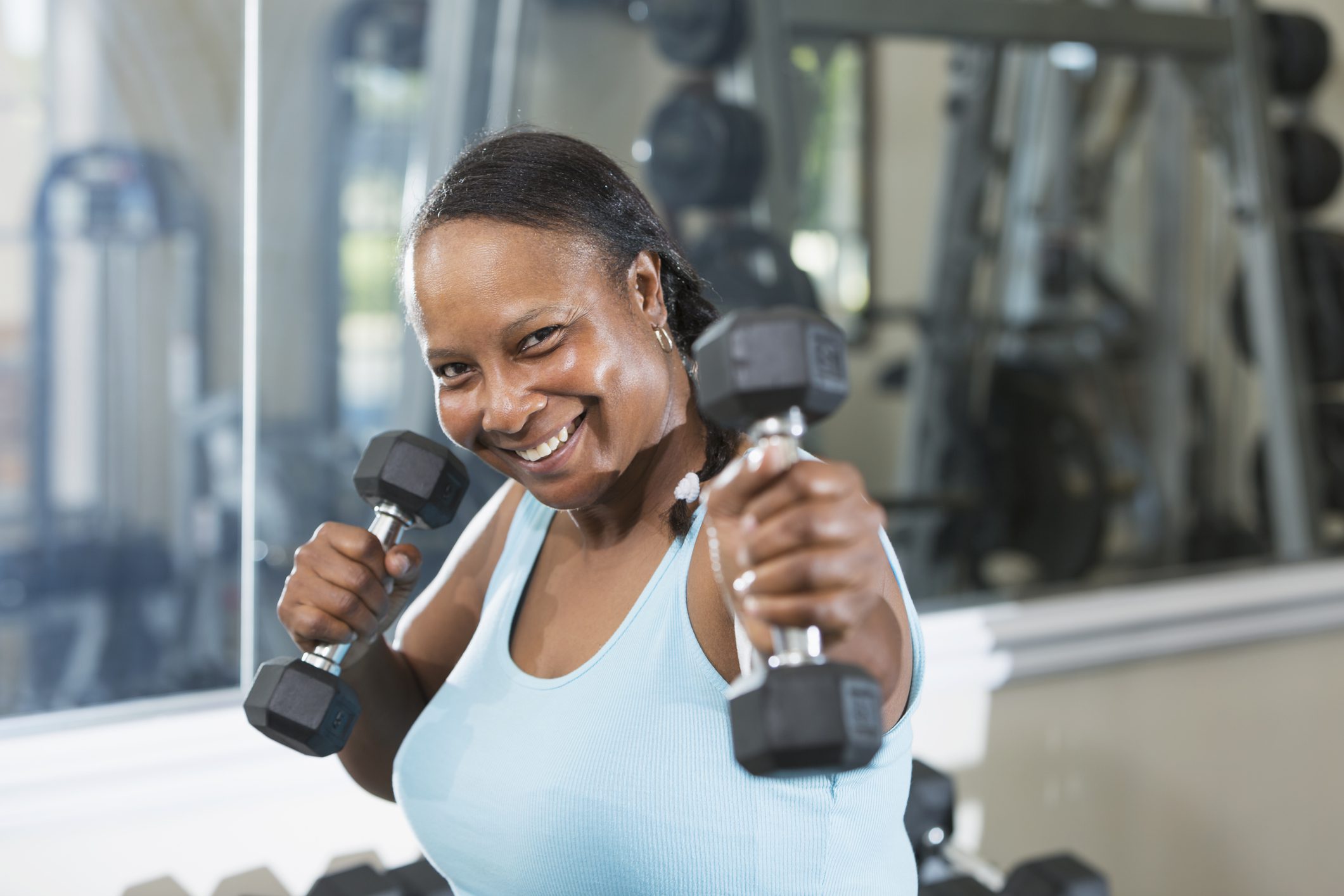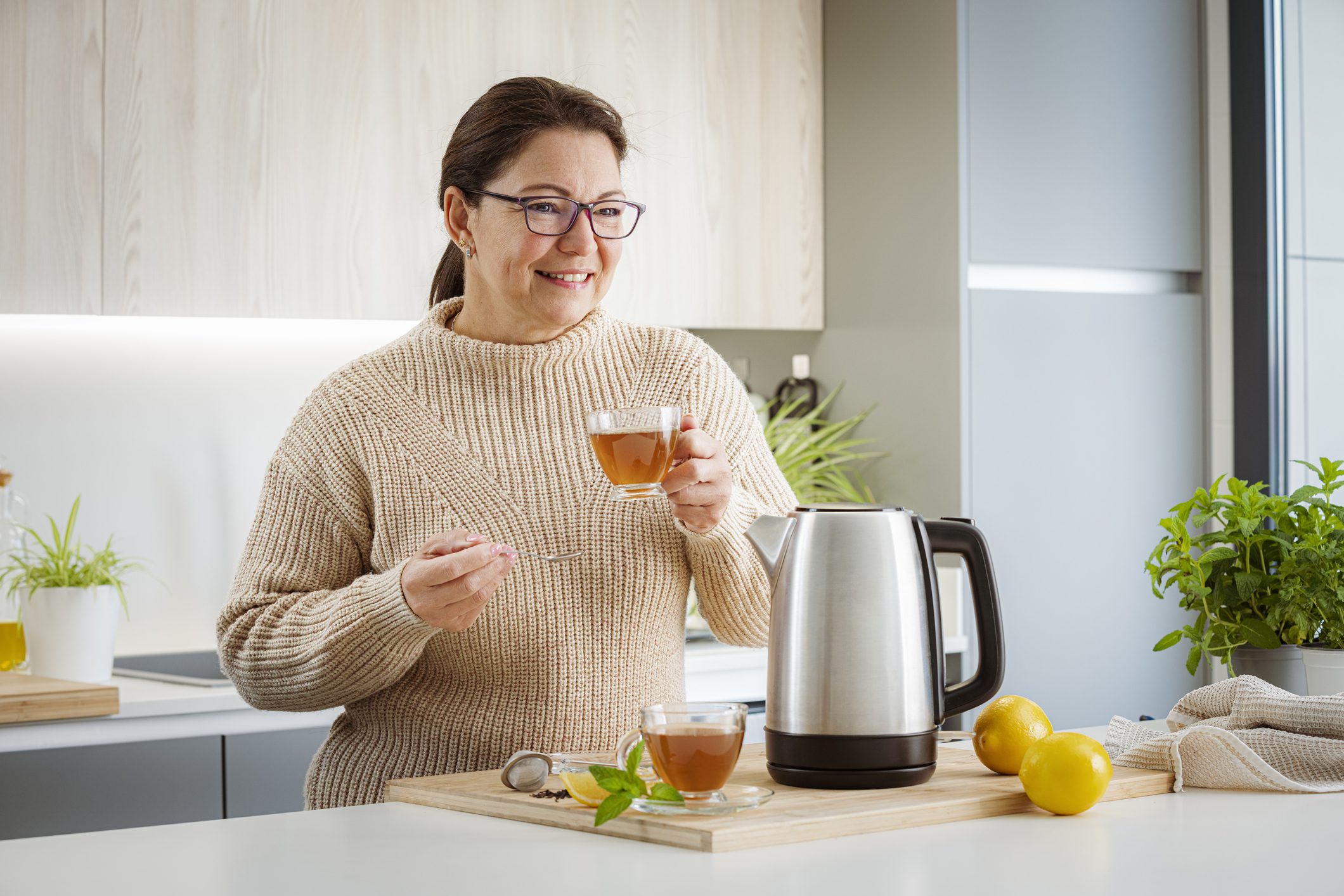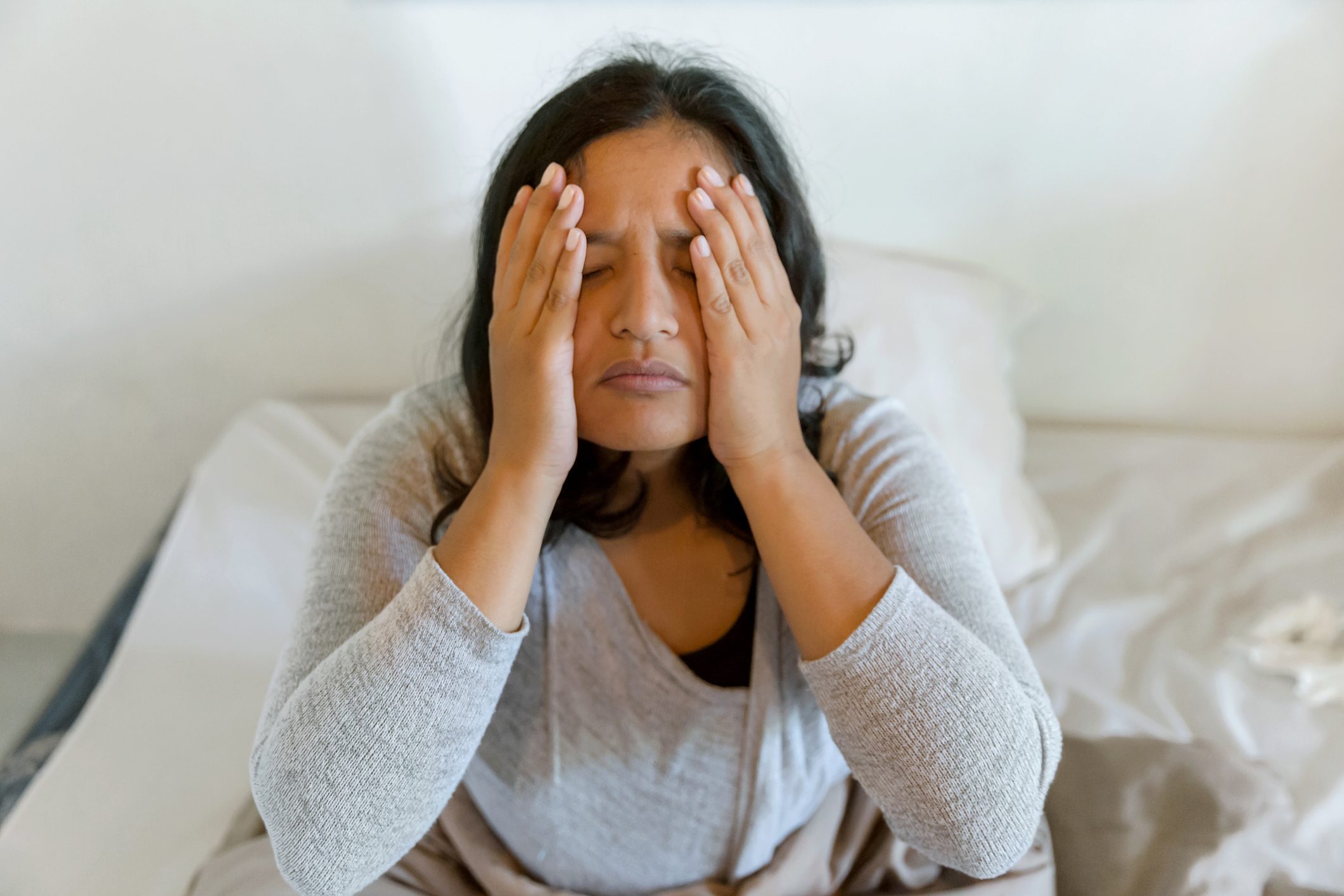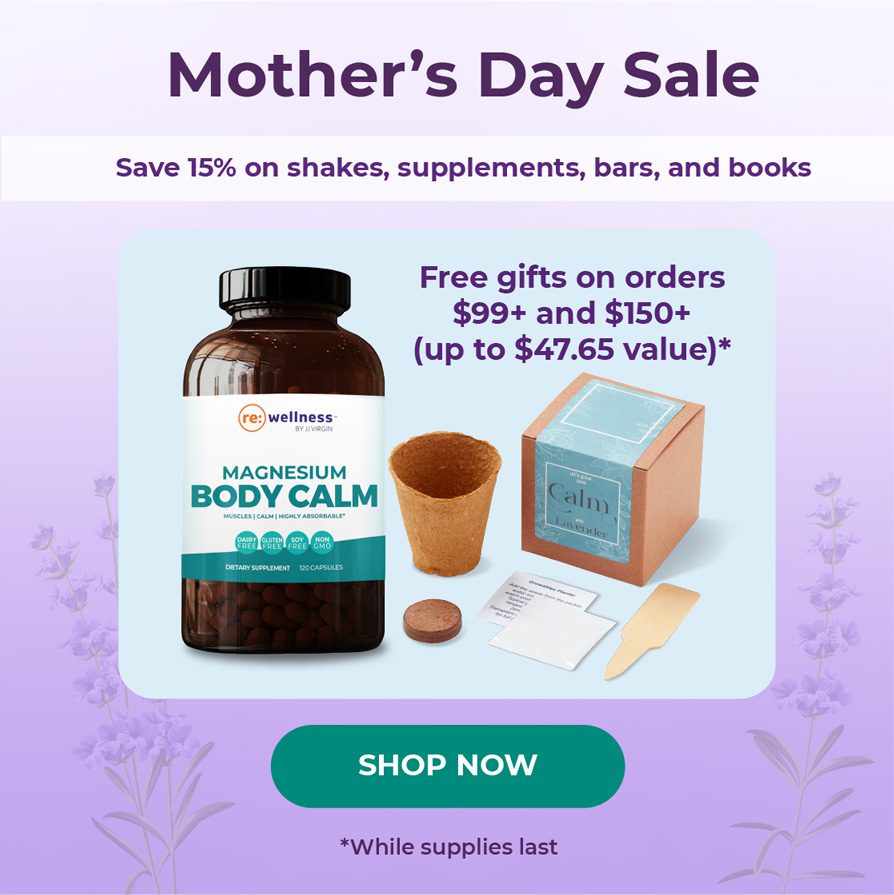I came out the other side of menopause looking and feeling better than ever. While I confronted the typical challenges that many other women experience, I also learned valuable strategies that can help you move through this life-changing situation.
One of the biggest hurdles women face during menopause is weight gain, or “menopause belly.”
On average, women gain 5-8% of their baseline body weight during menopause.1 That means if you weigh 150 pounds, you may gain about 7-12 pounds. Your first instinct is probably to find a new diet plan. But what if I told you that the number-one secret to losing weight around menopause isn’t what you eat?
I know that might sound surprising. But to avoid weight gain or lose menopause belly, what you lift is more important than going on a diet.
Don’t get me wrong—what you eat plays a massive role in managing your weight. So do things like stress management and getting the right nutrient support. But the biggest needle mover to overcoming menopause weight gain is putting on muscle.
What Causes Menopause Belly?
For many women, losing weight becomes harder during menopause because we’re gaining weight as visceral fat. This dangerous fat is more metabolically active than other types of fat, making it harder to lose and more likely to contribute to obesity-related diseases including cardiovascular disease and type 2 diabetes.2 Studies show that visceral fat increases with menopause.3
As a metabolically active fat, visceral fat produces various inflammatory substances. When you’re inflamed, a vicious cycle ensues: inflammation keeps your fat cells locked up, inhibiting fat loss (and making you more inflamed).
For many women, other factors exacerbate that weight gain. Your thyroid plays a crucial role in regulating metabolism. During menopause, thyroid dysfunction becomes more prevalent, creating stubborn belly fat and difficulties in losing weight.
Hormonal fluctuations around menopause also increases fat accumulation, especially around your midsection. Declining estrogen levels steal muscle and slow down your metabolism as well. Other hormones, including testosterone and progesterone, also fall out of balance. The dismal repercussion includes fat storage in your abdominal region.
While numerous culprits contribute to menopausal weight gain, let’s briefly look at three primary causes.
1. Your Stress Levels Are High
Menopause often brings higher stress levels. There are lots of reason stress skyrockets during this time, including symptoms like hot flashes, sleep disturbances, emotional shifts, and other life transitions such as your children leaving home.
When you’re stressed, you release cortisol. This stress hormone should be highest in the morning and gradually taper throughout the day. When cortisol stays elevated when it shouldn’t be, visceral fat tends to build up.4
High cortisol levels also contribute to cardiovascular disease, hot flashes, night sweats, mood swings, brain issues, bone loss, and insulin resistance.
Don’t let stress take down your day! Take Ten Stress Support is a uniquely formulated product that provides gamma-aminobutyric acid (GABA), a key neurotransmitter in the body involved in a normal, calm stress response. This synergistic formula also supplies other calming nutrients including glycine, niacinamide, pantothenic acid, and vitamin B6.*
2. You're More Insulin Resistant
Insulin resistance, where your cells “resist” this hormone and blood-sugar levels stay high, becomes more prevalent with age and as hormone levels fluctuate.
Several factors around menopause contribute to insulin resistance: you’re not sleeping well, your cortisol levels stay elevated when they shouldn’t be, you’re losing muscle mass, you’re not as physically active, and you’re chasing down high-sugar impact foods with a few glasses of wine or a cocktail.
Altogether, these obstacles hinder your body's ability to use glucose effectively, leading to increased fat storage. You end up with blood-sugar imbalances, which creates the conditions for insulin resistance (and eventually, type 2 diabetes).
3. You’re Losing Muscle Mass
With age and hormonal changes, women often lose muscle. Estrogen helps maintain muscle mass by supporting protein synthesis and inhibiting muscle breakdown. Decreases in estrogen impair your body's ability to build and preserve muscle diminishes.
As a result, your body becomes less efficient at utilizing glucose, leading to increased insulin resistance. (Are you starting to see a pattern here?) Muscle tissue burns more calories than fat tissue. When it declines, your metabolism slows down, making weight gain more likely.
How to Get Rid of Menopause Belly
During menopause, cumulative factors including insulin resistance, muscle loss, and high stress levels create a downward spiral, sparking the perfect storm for weight gain. But it’s not inevitable, and I’ve found the solution.
Instead of focusing on your weight right now, focus instead on improving what your weight is made up of. When you add muscle, you’ll naturally lose that dangerous visceral fat without dieting.
With that in mind, these five factors can help you banish menopause belly and reach your ideal weight.
Focus First on Fitness
I’ve long called muscle your metabolic Spanx because it keeps everything tighter. The muscle and bone loss that both accompany menopause can create disabilities and fall-related fractures in later life. 5
Strength training is the answer. I want you to lift heavy things, but that doesn’t necessarily mean free weights. You could build muscle using body weight or a TRX trainer. Whatever you decide, you’ll divide your body into four parts, and you’ll exercise each part two or three times a week:
- Upper body pushing
- Upper body pulling
- Hips and thighs
- Power core
For each of those four body parts, you’ll want to compound movements such as squats or bent-over rows, which also work your core.
I explain all this in more detail in my Resistance Training Cheat Sheet, which gives you everything you need for your fitness journey, including home gym essentials, an 8-week workout plan, and a progress tracker to track your sets, reps, and weights with each workout. It’s FREE, so grab yours here.
Along with strength training, you’ll want to do high-intensity interval training (HIIT), where you alternate short bursts of intense activity with brief periods of rest or lower-intensity activity. One small study showed that a six-week HIIT program among 16 perimenopausal women improved many health and performance parameters, including fat burning and body composition.6
You’ll also include zone-2 steady-state training, which helps your body become better at burning fat and supports heart health. Zone 2 includes moderate-intensity activities such as brisk walking, swimming, cycling, hiking, and rowing. By moderate intensity, I mean 60-70% of your maximum heart rate (where you can still maintain a conversation while exercising).
I want you to aim for at least 150 minutes every week in zone 2. You can weave zone 2 into HIIT, so you’ll have 4-8 minutes of HIIT daily and the rest as zone 2. Complement those efforts with flexibility movements like yoga.
Incorporate more movement throughout the day, too. Everything counts. Track your steps and aim for at least 7,000 steps daily. (Bonus points for an after-dinner walk!)
Together, combining strength training, HIIT, zone 2, and flexibility exercises like yoga create amazing shifts in your fat-burning abilities. Here’s how your weekly schedule might look:
- Resistance training three days a week
- Yoga one day a week
- HIIT three times a week (and ideally, you’ll follow HIIT with zone 2)
Eat Protein First at Every Meal
To win the menopause belly battle, eat protein first at every meal. This underrated macronutrient is a superstar to build muscle, boost your metabolism, balance blood sugar, and reach your weight-loss goals.
The average woman is getting an inadequate 45-60 grams of dietary protein a day. Instead, you’ll want to aim for 0.7-1 gram per pound of target body weight. If your goal weight is 150 pounds, that means about 105-150 grams of protein daily.
Because hormone shifts can break down muscle tissue, your body needs more protein during menopause to build muscle. You’ll want to include at least 30-50 grams of protein at every meal, especially your bumper meals (when you break your fast and your last meal of the day).
If you're trying to lose fat, exercise intensely, or you eat a plant-based diet, aim for the higher end of this spectrum. (Especially if you're vegan, optimize your protein intake with a plant-based protein powder.)
Track Your Progress
Eating by the plate with the magic trifecta of protein, fat, and fiber, along with the right kind of exercise, will fast-track you towards your goals. Plus, measuring your body composition will help you celebrate successes and pinpoint where you need to tweak.
I recommend investing in a bioimpedance scale (body-composition scale). Unlike a standard bathroom scale that only tells you your weight, a body composition scale identifies what your weight is made up of. Track your body weight daily and your body composition (including fat and muscle) weekly.
Remember, the goal is to put on muscle, not lose weight. If you're losing weight without losing your waist, you’re making yourself worse!
You’ll also want to track your macros. Monitoring and recording your daily food intake ensures that you’re meeting your protein and other nutrient needs (and you can make necessary adjustments if you aren’t).
My go-to tracker is the Cronometer app, which conveniently tracks your food, movement, and more to give you direct feedback. Tracking helps you know exactly how much protein you’re getting daily.

Other helpful metrics are your waist and hip measurements, which I suggest tracking weekly. Measure your waist by placing a tape measure around your body at the level of the uppermost part of your hip bone, usually at the level of the belly button. Measure your hips by standing with your feet together and measuring around the widest point, ensuring that the tape measure is level.
Finally, you’ll want to know your blood-sugar levels, too. I’ve learned that managing blood sugar is often the missing piece if you're doing everything “right” but still struggle to lose weight. Go with a continuous glucose monitor, which sends your glucose reading to an app and tracks your levels 24/7. This makes it easy to see how your meals are impacting you day to day.
Learn to Manage Stress
When you don’t manage stress well, higher cortisol levels mean you're going to break down muscle. High cortisol also messes with your sleep, which will hinder repair and recovery to build muscle. Stress impairs thyroid function, too. If your thyroid isn't working well, you’re not going to be able to build muscle.
My go-to way to manage stress is meditation. Dr. Joe Dispenza’s meditations have been a game-changer for me, but I didn’t get results overnight. You wouldn’t go to the gym for a week and think you should be fit. Why should meditation be different?
For me, the shift took several months, but it has been profound. Find something that works for you. That could be meditation, yoga, deep breathing, sound healing, forest bathing, Qigong, or tapping.
My #1 Supplement for Menopause Belly Fat
While it carries a bodybuilding reputation, creatine is critical around menopause for several reasons. Compared with men, women have 70-80% fewer tissue stores of creatine.7
Creatine deficiencies can become a problem with age. After 30, muscle mass decreases by about 3-8% every decade. By 60, that loss accelerates.8
Women also experience 10-20% bone loss in the years after menopause, increasing the risk of fractures and osteoporosis.9
Creatine supplementation can support muscle and bone loss during menopause while improving your overall body composition.10 When you don’t have enough creatine coming in, your body breaks down muscle tissue to get that creatine. Supplementing can improve your exercise performance, help you recover more quickly, and increase your fat-free muscle mass during menopause.
Saturating your tissues with creatine takes about a month. You can either take a standard dose of about 5 grams daily for a month, or you can expedite the process by taking 5 grams, four times a day, for five days. After that, you’ll use about 3-5 grams daily, depending on your weight. If you weigh 150 pounds, you’ll use 4 grams (modify accordingly for your weight).
Consistency is key: You’ll want to supplement every day to keep your tissues saturated so you don’t lose any of this nutrient’s many benefits!
Clean Creatine Powder is the purest form of creatine powder on the market, with only one ingredient: 100% creatine monohydrate. Each serving delivers a therapeutic 5 grams of this multitasking nutrient, with no fillers or other ingredients.* The flavorless powder mixes easily into your loaded smoothie or favorite beverage.
Menopause Belly Isn’t Inevitable
Menopause-related hormonal changes and age-related factors can lead to weight gain, especially dangerous visceral fat. But weight gain isn’t inevitable, and you have plenty of power to reach and maintain your goal body composition.
Yes, what you eat matters, but I want to shift the focus and make muscle a bigger priority. When you build muscle with strength training while consuming optimal protein at every meal, fat loss favorably shifts by itself. Battling menopause belly fat means eating protein first and putting on muscle. That’s the magic ticket to get rid of menopause belly naturally.
References:
- Right as Rain by UW Medicine: Menopause Weight Gain Is Common. Here’s How to Avoid It
- Liu FX, Flatt SW, Nichols JF, Pakiz B, Barkai HS, Wing DR, Heath DD, Rock CL. Factors Associated with Visceral Fat Loss in Response to a Multifaceted Weight Loss Intervention. J Obes Weight Loss Ther. 2017;7(4):346. doi: 10.4172/2165-7904.1000346. Epub 2017 Aug 14. PMID: 29629240; PMCID: PMC5889055.
- Janssen I, Powell LH, Kazlauskaite R, Dugan SA. Testosterone and visceral fat in midlife women: the Study of Women's Health Across the Nation (SWAN) fat patterning study. Obesity (Silver Spring). 2010 Mar;18(3):604-10. doi: 10.1038/oby.2009.251. Epub 2009 Aug 20. PMID: 19696765; PMCID: PMC2866448.
- Mattsson C, Olsson T. Estrogens and glucocorticoid hormones in adipose tissue metabolism. Curr Med Chem. 2007;14(27):2918-24. doi: 10.2174/092986707782359972. PMID: 18045137.
- Sipilä S, Törmäkangas T, Sillanpää E, Aukee P, Kujala UM, Kovanen V, Laakkonen EK. Muscle and bone mass in middle-aged women: role of menopausal status and physical activity. J Cachexia Sarcopenia Muscle. 2020 Jun;11(3):698-709. doi: 10.1002/jcsm.12547. Epub 2020 Feb 3. PMID: 32017473; PMCID: PMC7296268.
- Jabbour G, Iancu HD. Comparison of performance and health indicators between perimenopausal and postmenopausal obese women: the effect of high-intensity interval training (HIIT). Menopause. 2020 Sep 4;28(1):50-57. doi: 10.1097/GME.0000000000001654. PMID: 32898025.
- Smith-Ryan AE, Cabre HE, Eckerson JM, Candow DG. Creatine Supplementation in Women's Health: A Lifespan Perspective. Nutrients. 2021 Mar 8;13(3):877. doi: 10.3390/nu13030877. PMID: 33800439; PMCID: PMC7998865.
- Ji MX, Yu Q. Primary osteoporosis in postmenopausal women. Chronic Dis Transl Med. 2015 Mar 21;1(1):9-13. doi: 10.1016/j.cdtm.2015.02.006. PMID: 29062981; PMCID: PMC5643776.
- Scientific American: How To Keep Muscles Strong As You Age
- Smith-Ryan AE, Cabre HE, Eckerson JM, Candow DG. Creatine Supplementation in Women's Health: A Lifespan Perspective. Nutrients. 2021 Mar 8;13(3):877. doi: 10.3390/nu13030877. PMID: 33800439; PMCID: PMC7998865.
*These statements have not been evaluated by the Food & Drug Administration. Products mentioned are not intended to diagnose, treat, cure, or prevent any disease. The views in this blog by JJ Virgin should never be used as a substitute for professional medical advice. Please work with a healthcare practitioner concerning any medical problem or concern.






